Face (geometry)
고체 기하학(solid geometry)에서, 면(face)은 고체 대상의 경계의 일부를 형성하는 평평한 표면(surface) (평면(planar) 영역(region))입니다;[1] 면에 의해 배타적으로 경계진 삼-차원 고체는 다면체(polyhedron)입니다.
다면체와 고차원 폴리토프(polytopes)의 기하학의 보다 기술적인 처리에서, 그 용어는 역시 보다 일반적인 (차원의 임의의 숫자에서) 폴리토프의 임의의 차원의 원소를 의미하기 위해 사용됩니다.[2]
Polygonal face
기본 기하학에서, 면은 다면체(polyhedron)의 경계에 있는 다각형(polygon)입니다.[note 1][2][3] 다각형 면에 대해 다른 이름은 다면체 변(polyhedron side)과 유클리드 평면 타일(tile)을 포함합니다.
예를 들어, 정육면체(cube)를 묶는 6개의 정사각형(squares) 중 임의의 하나는 정육면체의 면입니다. 때때로 "면"은 4-폴리토프(4-polytope)의 2-차원 특색을 참조하기 위해 사용되기도 합니다. 이러한 의미와 함께, 4-차원 테서랙트(tesseract)는 24개의 정사각형 면을 가지며, 각 면은 8개의 정육면체(cubic) 셀 중 2개를 공유합니다.
| Polyhedron | Star polyhedron | Euclidean tiling | Hyperbolic tiling | 4-polytope |
|---|---|---|---|---|
| {4,3} | {5/2,5} | {4,4} | {4,5} | {4,3,3} |
 The cube has 3 square faces per vertex. |
 The small stellated dodecahedron has 5 pentagrammic faces per vertex. |
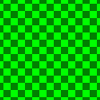 The square tiling in the Euclidean plane has 4 square faces per vertex. |
 The order-5 square tiling has 5 square faces per vertex. |
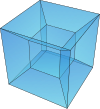 The tesseract has 3 square faces per edge. |
Number of polygonal faces of a polyhedron
임의의 볼록 다면체(convex polyhedron)의 표면은 다음 오일러 특성(Euler characteristic)을 가집니다:
여기서 는 꼭짓점(vertices)의 개수, 는 가장자리(edges)의 개수이고, 는 면의 개수입니다. 이 방정식은 오일러의 다면체 공식(Euler's polyhedron formula)으로 알려져 있습니다. 따라서 면의 개수는 가장자리의 개수에서 꼭짓점의 개수를 뺀 것보다 2만큼 더 많습니다. 예를 들어, 정육면체에는 12개의 가장자리와 8개의 꼭짓점을 가지므로, 따라서 6개의 면이 있습니다.
k-face
고-차원 기하학에서, 폴리토프(polytope)의 면은 모든 차원의 특색입니다.[2][4][5] 차원 의 면은 -면이라고 합니다. 예를 들어, 보통의 다면체의 다각형 면은 2-면입니다. 집합 이론(set theory)에서, 폴리토프의 면의 집합은 폴리토프 자체와 빈 집합을 포함되며, 여기서 빈 집합은 일관성을 위해 −1의 "차원"으로 주어집니다. 임의의 n-폴리토프 (n-차원 폴리토프)에 대해, −1 ≤ k ≤ n입니다.
예를 들어, 이 의미와 함께, 정육면체(cube)의 면은 정육면체 자체 (3-면), 그것의 (정사각형) 패싯(facets) (2-면), (선형) 가장자리 (1-면), (점) 꼭짓점 (0-면), 및 빈 집합을 포함합니다. 다음은 4-차원 폴리토프(4-dimensional polytope)의 면입니다:
- 4-면 – 4-차원 4-폴리토프(4-polytope) 자체
- 3-면 – 3-차웜 셀(cells) (다각형(polyhedral) 면)
- 2-면 – 2-차원 릿지(ridges) (다각형(polygonal) 면)
- 1-면 – 1-차원 가장자리(edges)
- 0-면 – 0-차원 꼭짓점(vertices)
- 빈 집합, 이것은 차원 −1을 가집니다
다면체 조합론(polyhedral combinatorics)과 같은 수학의 일부 영역에서, 폴리토프는 정의에 의해 볼록합니다. 공식적으로, 폴리토프 P의 면은 그것의 경계가 P의 내부와 서로소인 임의의 닫힌(closed) 절반-공간(halfspace)과 P의 교차점입니다.[6] 이 정의로부터, 폴리토프의 면의 집합은 폴리토프 자체와 빈 집합을 포함한다는 것이 따릅니다.[4][5]
추상 폴리토프(abstract polytopes)와 별 폴리토프(star polytopes) 이론과 같은 수학의 다른 영역에서, 볼록성에 대한 요구 사항이 완화됩니다. 추상 이론은 여전히 면의 집합이 폴리토프 자체와 빈 집합을 포함해야 한다고 요구합니다.
Cell or 3-face
셀은 4-차원 폴리토프 또는 3-차원 테셀레이션 이상의 다면체 원소 (3-면)입니다. 셀은 4-폴리토프 및 3-벌집에 대해 패싯(facets)입니다.
예제:
| 4-polytopes | 3-honeycombs | ||
|---|---|---|---|
| {4,3,3} | {5,3,3} | {4,3,4} | {5,3,4} |
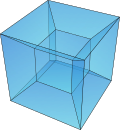 The tesseract has 3 cubic cells (3-faces) per edge. |
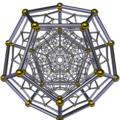 The 120-cell has 3 dodecahedral cells (3-faces) per edge. |
 The cubic honeycomb fills Euclidean 3-space with cubes, with 4 cells (3-faces) per edge. |
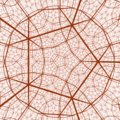 The order-4 dodecahedral honeycomb fills 3-dimensional hyperbolic space with dodecahedra, 4 cells (3-faces) per edge. |
Facet or (n − 1)-face
고차원 기하학에서, n-폴리토프의 패싯 (초면(하이퍼페이스)라고도 함)은[7] (n–1)-면 (폴리토프 자체보다 1 차원 작은 면)입니다.[8] 폴리토프는 그것의 패싯으로 경계집니다.
예를 들어:
- 선분(line segment)의 패싯은 그것의 0-면 또는 꼭짓점(vertices)입니다.
- 다각형(polygon)의 패싯은 그것의 1-면 또는 가장자리(edges)입니다.
- 다면체(polyhedron) 또는 평면 타일링(tiling)의 패싯은 그것의 2-면(2-faces)입니다.
- 4D 폴리토프(4D polytope) 또는 3-벌집(3-honeycomb)의 패싯은 그것의 3-면(3-faces) 또는 셀입니다.
- 5D 폴리토프(5D polytope) 또는 4-벌집의 패싯은 그것의 4-면(4-faces)입니다.
Ridge or (n − 2)-face
관련 용어로, n-폴리토프의 (n − 2)-면은 릿지(ridges) (역시 부분패싯(subfacets))이라고 합니다.[9] 릿지는 폴리토프 또는 벌집의 정확히 두 면 사이의 경계로 보입니다.
예를 들어:
- 2D 다각형(polygon) 또는 1D 타일링의 릿지는 그것의 0-면 또는 꼭짓점(vertices)입니다.
- 다면체(polyhedron) 또는 평면 타일링(tiling)의 릿지는 그것의 1-면 또는 가장자리(edges)입니다.
- 4D 폴리토프(4D polytope) 또는 3-벌집(3-honeycomb)의 릿지는 그것의 2-면 또는 단순히 면(faces)입니다.
- 5D 폴리토프(5D polytope) 또는 4-벌집의 릿지는 그것의 3-면 또는 셀(cells)입니다.
Peak or (n − 3)-face
n-폴리토프의 (n − 3)-면은 피크(peaks)라고 합니다. 피크는 정규 폴리토프 또는 벌집에서 패싯과 릿지의 회전 축을 포함합니다.
예를 들어:
- 3D 다면체(polyhedron) 또는 평면 타일링(tiling)의 피크는 그것의 0-면 또는 꼭짓점(vertices)입니다.
- 4D 폴리토프(4D polytope) 또는 3-벌집(3-honeycomb)의 피크는 그것의 1-면 또는 가장자리(edges)입니다.
- 5D 폴리토프(5D polytope) 또는 4-벌집의 피크는 그것의 2-면 또는 간단히 면(faces)입니다.
See also
Notes
- ^ Some other polygons, which are not faces, are also important for polyhedra and tilings. These include Petrie polygons, vertex figures and facets (flat polygons formed by coplanar vertices that do not lie in the same face of the polyhedron).
References
- ^ Merriam-Webster's Collegiate Dictionary (Eleventh ed.). Springfield, MA: Merriam-Webster. 2004.
- ^ a b c Matoušek, Jiří (2002), Lectures in Discrete Geometry, Graduate Texts in Mathematics, vol. 212, Springer, 5.3 Faces of a Convex Polytope, p. 86, ISBN 9780387953748.
- ^ Cromwell, Peter R. (1999), Polyhedra, Cambridge University Press, p. 13, ISBN 9780521664059.
- ^ a b Grünbaum, Branko (2003), Convex Polytopes, Graduate Texts in Mathematics, vol. 221 (2nd ed.), Springer, p. 17.
- ^ a b Ziegler, Günter M. (1995), Lectures on Polytopes, Graduate Texts in Mathematics, vol. 152, Springer, Definition 2.1, p. 51, ISBN 9780387943657.
- ^ Matoušek (2002) and Ziegler (1995) use a slightly different but equivalent definition, which amounts to intersecting P with either a hyperplane disjoint from the interior of P or the whole space.
- ^ N.W. Johnson: Geometries and Transformations, (2018) ISBN 978-1-107-10340-5 Chapter 11: Finite symmetry groups, 11.1 Polytopes and Honeycombs, p.225
- ^ Matoušek (2002), p. 87; Grünbaum (2003), p. 27; Ziegler (1995), p. 17.
- ^ Matoušek (2002), p. 87; Ziegler (1995), p. 71.
External links
- Weisstein, Eric W. "Face". MathWorld.
- Weisstein, Eric W. "Facet". MathWorld.
- Weisstein, Eric W. "Side". MathWorld.





